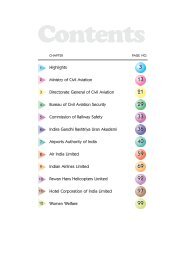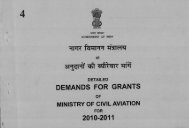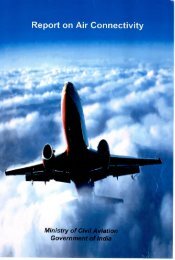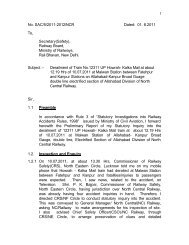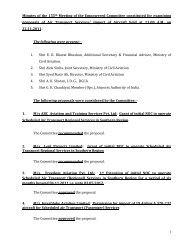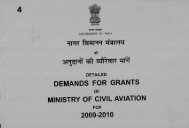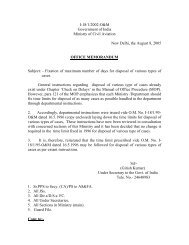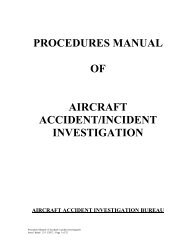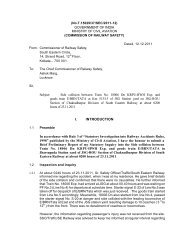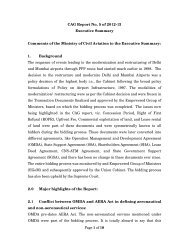3 - Ministry of Civil Aviation
3 - Ministry of Civil Aviation
3 - Ministry of Civil Aviation
You also want an ePaper? Increase the reach of your titles
YUMPU automatically turns print PDFs into web optimized ePapers that Google loves.
Committee endorses the recent government decision to do away with the earlier proposal <strong>of</strong> notallowing greenfield airports within, an aerial distance <strong>of</strong> 150 kilometres <strong>of</strong> an existing airport.The Committee, however, suggests that central, and state governments may refrain fromextending concessions in general and subsidies in particular to greenfield airports in closeproximity to the existing airports, which might impinge on the viability <strong>of</strong> existing airports.<strong>Ministry</strong> <strong>of</strong> Home Affairs: At international airports, the operators must ensureavailability <strong>of</strong> more space so as to enable the <strong>Ministry</strong> <strong>of</strong> Home Affairs to locate additionalcounters and deploy more immigration <strong>of</strong>ficers. The computer systems at airports should beupgraded within a one year time-frame and the government should ensure that all passportsare machine-readable. Furthermore, the paperwork involved in immigration should be reducedin line with international practices. There should be a dedicated cadre <strong>of</strong> specially trained<strong>of</strong>ficers under the direct control <strong>of</strong> <strong>Ministry</strong> <strong>of</strong> Home Affairs for providing immigration services.As aviation and airport security are sovereign responsibilities, they should be taken over andfunded by the <strong>Ministry</strong> <strong>of</strong> Home Affairs.<strong>Ministry</strong> <strong>of</strong> Defence: In order to optimise the use <strong>of</strong> air space, the Committeerecommends that the government may consider the model followed in the U.S. and many othercountries, wherein air space is permanently made available for civil aviation and segments <strong>of</strong>air space are re-vested and made available to defence on request. Furthermore, the defenceservices should be required to pay user charges as mutually agreed upon for facilities such asrunways. To facilitate effective co-ordination <strong>of</strong> air space and cost-sharing, civil and defenceATCs may be co-located where feasible.7.3 Air Transport ServicesIn the domestic air transport segment, route dispersal guidelines should be abolishedand airlines should be allowed to service the routes <strong>of</strong> their choice based upon commercialconsiderations. Simultaneously, the government should provide explicit subsidy support —preferably from the general exchequer and. supplemented by a sector-specific cess <strong>of</strong> 5% onairfare and proceeds from the privatisation <strong>of</strong> airports — for providing essential, butuneconomical services, and award it through a system <strong>of</strong> minimum subsidy bidding. Towardsthis end, a non-lapsable Essential Air Services Fund (EASF) should be established outside theConsolidated Fund <strong>of</strong> India and its management should be vested with an independent board.The government should fully harness the scope for recovering the cost <strong>of</strong> EAS operations, as faras possible, through direct user charges. Furthermore, the state governments may contribute tothe lowering <strong>of</strong> the net cost <strong>of</strong> EAS through fiscal concessions, as for example, by exempting theEAS operations from high incidence <strong>of</strong> sales tax on ATF. In addition, the Committeerecommends that requirements regarding fleet size and equity capital should be removed, so asto encourage entry (and greater competition) and allow operators and their financiers to makedecisions based on commercial considerations. Finally, foreign equity investment normspertaining to both domestic and international scheduled air transport services should be furtherliberalised, to allow up to. 49% foreign investment. As regards investment by foreign airlines,investment up to 49% may be allowed with the approval <strong>of</strong> Foreign Investment PromotionBoard (FIPB). In all other air services, i.e., non-scheduled services such as helicopter



